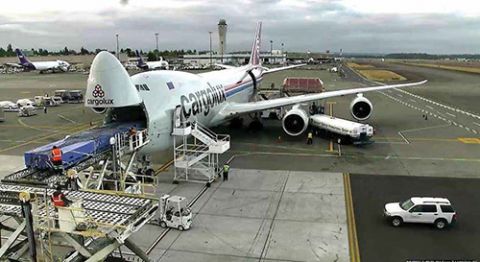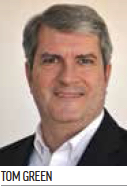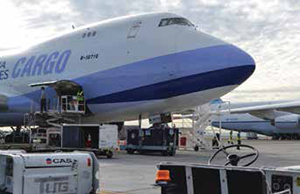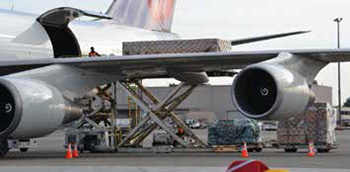Sea-Tac Int’l Makes More Room for Mega-Freighters

In June 2015, Seattle-Tacoma International Airport (SEA) completed a $23 million cargo expansion project designed to support the growing cargo demand the airport is experiencing and hopes to increase.
Two cargo areas north of the main terminal were expanded to accommodate simultaneous nose-loading of large aircraft like Boeing 747-8s. Because such aircraft have longer wingspans and fuselages, they require more ramp space to park, unload and load freight. Tom Green, senior manager of air cargo at SEA, says the facility enhancements will improve the efficiency of ground operations and make the airport’s air cargo business more competitive.
 facts&figures facts&figuresProject: Cargo Facility Expansion Location: Seattle-Tacoma Int’l Airport Total Cost: $23 million Construction: Spring 2014 – early 2015 General Contractor: Gary Merlino Construction Co. Electrical Contractor: Foy Group Building Subcontractor: Jody Miller Construction Fuel System Subcontractor: SE Pipeline Construction Ground Power Units: Cavotec Cargo Airlines: Asiana, Cargolux, China Airlines, EVA Air, FedEx, Korean Air, Singapore Airlines Charters During Cherry Season: Atlas Air, China Cargo, Nippon Cargo, Polar Air |
While SEA is not typically considered a major player in cargo, Green notes that the Washington airport is growing in the sector, and recent investments will further its growth. “It was incumbent upon us on the cargo and freight side to point out our importance in the operation, but also to point out that capital improvement projects are necessary for the cargo side — even at a gateway airport that folks would say is primarily a passenger operation.”
To his point, SEA served 42 million passengers last year. Cargo volume, however, is on the rise. In 2014, the airport’s total cargo tonnage increased 11.8%, with a total of 327,240 metric tons. Notably, it logged a record 107,752 metric tons of international freight — an increase of 21.6%. And last year, SEA sustained that growth and increased another 1.7%. “Both years, that growth was propelled by growth on the international side,” Green notes. More than half the cargo SEA manages (54.4% in 2015) is carried by freighter aircraft.
According to records from the Port of Seattle, $12.7 billion worth of airfreight is exported to domestic and international markets through SEA each year, and another $13.6 billion is imported. According to estimates, that volume brings about $22.7 billion in economic value to the state of Washington each year.
Currently, the biggest aircraft seem to hold the biggest potential for cargo growth at SEA. In 2014, the airport experienced a 10.4% increase in frequency from the largest class of cargo aircraft, such as Boeing 747 freighters and Antonov 124s; and that growth continued in 2015 with another 7.6% increase. Last year, SEA handled 1,050 mega freighters. “For an airport of our size, that was a pretty momentous number of annual operations from that size freighter,” notes Green.
SEA officials anticipate continued growth from the highest volume aircraft. “We believe the industry took note of our efforts to expand the parking areas and the fact that it just makes it easier to work here,” he explains. “We think we made a sensible bet at a relatively minimal cost to preserve and grow that side of the business.”
Facility Expansion
Planning for the $23 million expansion began in 2012, with approval secured in 2013 and groundbreaking in 2014. The Port of Seattle, which operates the airport, led the planning and design processes.
The team chose to expand the size of hardstands at both cargo areas (one midfield, another on the north side) to benefit all of SEA’s large scheduled freight carriers. “We didn’t want to concentrate them all in one place,” Green explains.
In response to recent traffic trends at the airport, the expansion’s primary goal was to better accommodate nose-loading operations by making the hardstands longer from nose to tail, with special attention to the space available in front, Green notes.
 Prior to the expansion, SEA had only one freighter hardstand position capable of handling Group 6 aircraft like the Boeing 747-8F. With at least two existing customers flying larger equipment, Cargolux and Korean Air Cargo, airport officials knew that a single hardstand for such aircraft was not enough to grow cargo operations, Green explains.
Prior to the expansion, SEA had only one freighter hardstand position capable of handling Group 6 aircraft like the Boeing 747-8F. With at least two existing customers flying larger equipment, Cargolux and Korean Air Cargo, airport officials knew that a single hardstand for such aircraft was not enough to grow cargo operations, Green explains.
In addition to its Group 6-capable hardstand, SEA also had other stands capable of handling aircraft as large as 747-400 freighters; but they just weren’t deep enough for optimum efficiency. To nose-load cargo, operators had to park planes diagonally across more than one hardstand — even 400 series aircraft, notes Green. “In order to have a facility that would allow growth in the future, we needed to expand some of those freighter hardstands,” he summarizes.
Previously, the hardstands allowed for about 50 feet off the nose. The new configuration includes more than twice as much space. “There’s a lot of activity with very high-value cargo that’s going on in a nose-load situation,” Green states. “We were trying to create an environment where our operators don’t face congestion and difficulty.” The new, deeper spaces allow cargo operators to be more efficient and effective, he reports.
 Both freighter and nose-loading operations are important for SEA, Green specifies. While belly cargo is where it’s at for many airports, the mix of commodities and aircraft flying into SEA made it necessary for the airport to accommodate nose-loading.
Both freighter and nose-loading operations are important for SEA, Green specifies. While belly cargo is where it’s at for many airports, the mix of commodities and aircraft flying into SEA made it necessary for the airport to accommodate nose-loading.
Cherries are one of the airport’s most important cargo commodities. In fact, airfreight volume typically peaks at SEA in July, due to seasonal exports of Pacific Northwest cherries. In 2014, the airport handled about 14,500 metric tons of the sweet, local product, which is considered a delicacy in Asia. During peak cherry season, it’s not unusual for all of SEA’s hardstands to be full with freighters, Green reports.
The new layout for both cargo areas includes ample room for loading and unloading aircraft, plus space for support vehicles, tugs and other equipment associated with the turn process. Previously, support activity would spill to both sides of the aircraft, impinging on the neighboring ramp where other airlines were working. “Through this project, we were able to push a lot of that operational and staging area toward the front of the aircraft,” Green relates. The result is much more efficient cargo operations for everyone, he adds.
Cargo airlines at SEA include FedEx, Cargolux, Korean Air, Asiana, China Airlines, EVA Air and Singapore Airlines. During cherry season, charter flights from China Cargo, Nippon Cargo, Polar Air and Atlas Air are also common.
 Finding Space
Finding Space
To prepare for the expansion of its northern cargo area, the airport had to remove one airside cargo building. “We have to take a systems approach to airfield planning and infrastructure,” Green explains. “All the buildings in the world aren’t going to help you with freighter business unless you have room to park those freighters.”
Ultimately, aircraft parking positions took precedence, and buildings to accommodate operations were fit in and around them, he elaborates.
With a relatively constrained footprint in terms of available acreage, SEA had to expand cargo facilities where it made sense, with any space that could be spared. After reviewing multiple alternatives, officials chose to take out the one building they felt they could do without, Green explains.
 In addition to physical expansion, the project modernized existing cargo facilities. The airport leveraged the construction process as an opportunity to install equipment such as nose wheel tethers and in-ground power units. Crews also updated lighting and extended the airport’s in-ground fuel hydrant system in one area.
In addition to physical expansion, the project modernized existing cargo facilities. The airport leveraged the construction process as an opportunity to install equipment such as nose wheel tethers and in-ground power units. Crews also updated lighting and extended the airport’s in-ground fuel hydrant system in one area.
The recent addition of ground power allows freight carriers to power on-board electrical systems by plugging into the airport’s new equipment rather than running aircraft auxiliary power units or diesel units on the ground. This helps SEA’s carriers save money, because they will burn less fuel, notes Green. It also helps reduce noise and emissions at the airport. “The city of Seattle, Washington state and the Port of Seattle are all very committed to green design elements,” he comments.
The extension of SEA’s in-ground fuel hydrant system provides additional environmental benefits, because freighters can now fuel directly from the hydrant rather than from fuel tankers that burn fuel and create emissions. Reducing ground traffic on the airfield also increases safety, adds Green.
Select light pole stands were relocated to save energy and improve lighting conditions. Crews also added a new camera system to boost safety and security in cargo areas.
Associated improvements to security gates on and off the airfield were made to provide trucks with more efficient and secure access to the airfield. Gate changes were not part of the primary project’s $23 million budget.
Construction & Coordination Challenges
Expansion of SEA’s cargo areas did not take place in a bubble. It was carefully planned and phased around the peak cargo season and everyday passenger operations, specifies Green. The constrained nature of the airfield required precision, but also complicated the process. “We really didn’t have the luxury to take too much of our parking inventory out of service and had to do it in pieces,” he recalls.
Construction started with the northern hardstand in spring 2014. Crews demolished the previous cargo building, expanded the concrete and most of the associated infrastructure, and finished other improvements. Projects were scheduled and completed so the area was back in operation before the busy summer cherry season began.
With the northern expansion complete, attention turned to the midfield cargo area in fall 2014 — after cherry season had ended. Although the midfield project took a little longer because winter rains interrupted concrete work, the entire project was completed in early 2015.
In addition to careful phasing, the project also required close coordination of its various elements, Green recalls. For instance, tying new elements into the fuel hydrant system required SEA to temporarily shut down one of its major fueling racks. Naturally, project planners timed the shutdown to minimize the impact on passenger and cargo airlines. Expediting the most disruptive work and communicating with everyone affected were also critical factors for a smooth transition, advises Green.
Expansion of SEA’s cargo area also provided additional remain overnight (RON) parking, a valuable commodity for any West Coast airport. The new Group 6 hardstands are capable of accommodating double-stacked aircraft such as 737 RON passenger jets. Although airfield personnel need to manage traffic so parked aircraft don’t impede active operations, the additional space is beneficial, says Green.
The recent expansion also provides a remote area for aircraft deicing, which is rarely needed at SEA. “Having larger areas of concrete makes that a more flexible and efficient process,” notes Green.
More Changes Ahead
As the airport continues to update its master plan, further changes to the cargo landscape are inevitable, says Green. A future terminal expansion needed to meet passenger demand will likely impact cargo areas; but planners haven’t yet determined the extent of the effect.
Based on current projects, SEA will reach 66 million passengers by 2034. “[Cargo is] going to be a smaller footprint on the airfield, so we will then need to plunge into relocating and rebuilding cargo building facilities,” Green predicts. “We’ll need to be much more efficient in how we provide cargo throughput buildings that are associated with these parking ramps. That’s going to be our next challenge.”
SEA officials expect to complete the current master plan update later this year.
The Port of Seattle Commission, which operates the airport and seaport, marked the Port’s 100-year anniversary in 2011 by creating policy objectives for both entities. One of SEA’s specific targets is to nearly triple its cargo tonnage by 2036. According to Green, the ambitious goal shows that the Port Commission recognizes the important role air cargo plays for industries in Seattle and throughout the state.
FREE Whitepaper
PAVIX: Proven Winner for All Airport Concrete Infrastructure
International Chem-Crete Corporation (ICC) manufactures and sells PAVIX, a unique line of crystalline waterproofing products that penetrate into the surface of cured concrete to fill and seal pores and capillary voids, creating a long lasting protective zone within the concrete substrate.
Once concrete is treated, water is prevented from penetrating through this protective zone and causing associated damage, such as freeze-thaw cracking, reinforcing steel corrosion, chloride ion penetration, and ASR related cracking.
This white paper discusses how the PAVIX CCC100 technology works and its applications.








